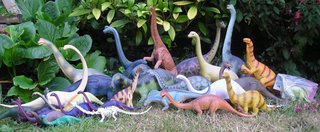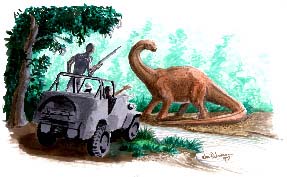
July 25, 2009
What colors are the extinct gigantic reptiles, just gray? Or maybe dull brown? Obviously, if you look at some toys your kids are playing with, then dinosaurs must have been orange, red and blue.
Then maybe too, dinosaurs aren’t extinct, if some people are correct.
Since an earlier version of this discussion was posted over a recent holiday weekend, some of you may have missed it. Here is a quick revisit of the issue of colors, living dinosaurs, and more, with several new images added.
One fun resource I did want to mention, even though I don’t have a review copy yet, is Karl Shuker’s book shown below. It looks like a good one.
Needless to say, those that study such things can’t even tell us what colors extinct dinosaurs were.
Furthermore, we don’t know whether any of the reports from South America, Asia, and Africa of Mokele-mbembe and their kin are even really living dinosaurs.
The schools of thought clearly divide along strict lines of thought here. Bernard Heuvelmans, Karl Shuker, and others think Mokele-mbembe and other similar cryptids are sauropods and their relatives, truly living dinosaurs. Based on those theories, thus, you will find dinosaur models in creationist museums reinforcing the notion that humans and dinos roamed the Earth together. On the other hand, Darren Naish, yours truly, and some others tend to not think in terms of “living dinosaurs” as part of zoological reality (and I’m not talking about the birds-are-dinos argument here, by the way).
As I said in a field guide passage about reports of dinosaurs, I sense the sightings are made up of “mistakes, monitors, and mammals.”
But this article is not about what the reports are, and I don’t want to revisit that debate today. This posting is about what colors “living dinosaurs” might be.
So, let’s just say that dinosaurs are still around. What does the considered opinion of paleontology combined with cryptozoology tell us about what colors that the living dinosaurs might be?
What colors are dinosaurs? We don’t know, but that hasn’t stopped people from speculating. Most folks looking at restoring colors of dinosaurs start with the animals they know.
There is considerable variation in the soft-tissue anatomy of animals living today. Take, for example, a lion and a tiger. Although they’re nearly identical at the skeletal level, both have drastically different physical appearances–one with a large mane in the males and a very drab tan color, and the other with orange and black stripes. The same applies to birds and many other animals.
For the sake of completeness, I should discuss the relative lack of variation in some animals, notably elephants, rhinos, etc. The coloration is relatively consistant (gray). Maybe [there is] a correlation between size and color (the bigger the drabber?)? ~ Andy Farke, commenting on “Restoring Dinosaurs,” 1998.
Hadrosaurs were one of the most widespread and also last surviving forms of dinosaurs.
Have you ever noticed the wide variety of colors that replica makers have given to the hadrosaurs?
Because the skin is fossilized, paleontologist Phillip Manning of Manchester University in England who has studied it cannot be sure what color the hadrosaur was. But there does seem to be a pattern of banding (striping) to its scales. Some scientists think hadrosaur’s skin might have had the ability to change colors, like the skin of some modern-day reptiles (e.g. anoles and chameleons).
What colors were dinosaurs? (Please note, some government stamp makers don’t even know that some of the large extinct reptiles they have on their stamps are not dinosaurs. Oh well, sometimes education is an uphill battle.)
Here are some typical answers to that question. Most of the ones you find are variations on the same themes.
United States Geological Service: Direct fossil evidence for dinosaur skin color is unknown. Paleontologists think that some dinosaurs likely had protective coloration, such as pale undersides to reduce shadows, irregular color patterns (“camouflage”) to make them less visible in vegetation, and so on. Those dinosaurs that had enough armor, such as the stegosaurs and ceratopsians, may not have needed protective coloration but may have been brightly colored as a warning to predators or as a display for finding a mate. Most dinosaurs probably were as brightly colored as modern lizards, snakes, or birds.
Scholastic.com: Many believe that dinosaur skin was probably drab shades of gray or green, allowing them to blend into their surrounding environments. This dull coloration would help them escape the detection of predators, enabling some to survive longer. Because large modern-day warm-blooded animals, such as elephants and rhinoceroses, tend to be dully colored, many scientists think that dinosaurs were, too.
But other paleontologists say the opposite is true — that dinosaurs’ skin could have been shades of purple, orange, red, even yellow with pink and blue spots! Rich and varied colors, they argue, might have helped dinosaurs to recognize one another and attract mates. Because research has shown that dinosaurs’ closest living relatives — birds — can see in color, it is theorized that dinosaurs could, too. Scientists in this camp believe that color may well have been as important to these ancient creatures as it is to us.
Jack Horner, Curator of Paleontology at the Museum of the Rockies: Some male dinosaurs may have had brightly colored crests to help them attract mates, but females probably did not. This color differentiation is also found in many modern-day birds.
If we are talking about feathered dinosaurs, well, the choices go in two directions there too.
Darren Naish, for example, talks about the colors of feathered dinos in the midst of a book review (here) and clearly some artists have a better take than others. But colors are all about imagining, in the end, even if the art is based on good science.
Among cryptid depictions, even one well-known illustrator, William Rebsamen, shows two different colors for Mokele-mbembe.

Mokele-mbembe, sauropod-like, are reported to be “reddish-brown to gray.” South American dinosaur-like creatures are merely said to be “dark.” Some Chinese “living dinosaurs,” said to look like hadrosaurs, are characterized as “black.”
What do you think?
Mokele-mbembe art courtesy of Bill Rebsamen. Click on images above for larger views.
Thanks to Darren Naish for sharing his groups of dinosaur replica images above.
About Loren Coleman
Loren Coleman is one of the world’s leading cryptozoologists, some say “the” leading living cryptozoologist. Certainly, he is acknowledged as the current living American researcher and writer who has most popularized cryptozoology in the late 20th and early 21st centuries.
Starting his fieldwork and investigations in 1960, after traveling and trekking extensively in pursuit of cryptozoological mysteries, Coleman began writing to share his experiences in 1969. An honorary member of Ivan T. Sanderson’s Society for the Investigation of the Unexplained in the 1970s, Coleman has been bestowed with similar honorary memberships of the North Idaho College Cryptozoology Club in 1983, and in subsequent years, that of the British Columbia Scientific Cryptozoology Club, CryptoSafari International, and other international organizations. He was also a Life Member and Benefactor of the International Society of Cryptozoology (now-defunct).
Loren Coleman’s daily blog, as a member of the Cryptomundo Team, served as an ongoing avenue of communication for the ever-growing body of cryptozoo news from 2005 through 2013. He returned as an infrequent contributor beginning Halloween week of 2015.
Coleman is the founder in 2003, and current director of the International Cryptozoology Museum in Portland, Maine.
Filed under Cryptomundo Exclusive, Cryptotourism, CryptoZoo News, Extinct, Eyewitness Accounts, Folklore, Fossil Finds, Living Dinosaurs, Living Fossils, Megafauna, Mokele-Mbembe, Replica Cryptia